We have many ways of describing library users in articles and policies that discuss our services. Historically, many institutions have referred to library users as “patrons” because they don’t pay directly for services and products. These librarians believe this terminology distinguishes the community-centered, non-profit environment of a library from the business world, which gave us the word “customer.” Although this isn’t simply a contemporary perspective, a substantial number of librarians have come to prefer the latter term, feeling that this language encourages staff to have a service orientation that creates a positive experience with library services and spaces. Grappling with what to call library users, and why, has gone on for more than a century. The list of terms includes “borrowers” (most often seen in public libraries), “readers” (in archives and special collections), and others such as a person’s role in the organization, like “students” and “faculty” in academic libraries, “attorneys” and “staff” in a corporate environment, and “service members” and “families” in the Department of Defense’s Morale, Welfare, and Recreation Libraries. Although we often employ the term “users” in this book, the term has been seen objections from librarians who worry that it could be confused with “‘those who take drugs.’”[1] There are further nuances as well. The phrase “new Iowans,” rather than immigrants, is seen as a way of reducing bias and attention to a library user’s national origins, much as we might refer to library users with disabilities or special needs, rather than disabled or handicapped users. Everyone who voices an opinion about this core terminology agrees about something, even when they disagree on labels: What we call library users matters, especially since it frames how library staff approach their work.
A library historian, Wayne Wiegand, popularized the distinction between centering “the library in the life of the user” and “the user in the life of the library.” He meant that while it is easy to think about how patrons figure into how we run a library, responding effectively to patrons means adopting their perspectives on libraries. Library users have different ideas about the places where we spend our careers, and meeting their needs effectively begins with reflecting on users’ attitudes and expectations, rather than focusing on library efforts to manage circulation, patron conduct, book challenges, and other issues typically encoded in policy and even state statutes. As you think about serving library users—and non-users, who are likewise entitled to library services—it is essential to consider how our buildings, policies, and resources might appear to non-librarians, and whether our institutional norms might pose barriers to serving users. Many individuals will have experiences with other libraries before they set foot in your library, or, because of those previous encounters, may decide that they aren’t welcome in any library.
The question, “How do you use libraries?” should prompt reflection on your habits, expectations, and preferences for particular libraries and their resources. Awareness of how you acquired those ideas is the starting point for recognizing that your experiences aren’t universal or happenstance. In the context of the ideas we’ve encountered thus far in this course, this program, and our lives, it doesn’t take long for us to recognize that this starting question rests on assumptions and behaviors that we’ve almost certainly internalized: We arrive with ideas about what libraries are and what they do for their users. We assume that we are allowed and even expected to use libraries, whether their physical spaces, their material collections, or the digital sources they provide. One of our key professional questions, both in the context of our degree work and in the lived reality of library work, is how we ensure that other people—including those who haven’t thought of themselves as library users—can acquire comfort and familiarity with library services. The answers have to do with our profession’s norms and values, practices identified through research, and the mindset and manners we bring to each interaction with community members.
As we examine what it means to serve library users, I’d like you to consider your responses to the following questions:
- What motivates you to visit a library in person or online?
- Has your library use changed with time, with shifts in your role or identity, with new interests or needs?
- Do you use more than one library? Do you use these libraries differently?
- Do you suppose your library use is the same or different from other individuals in your community? Why?
- What makes you feel welcome in a new library? What have other librarians done to make you feel supported, respected, and at ease as you used their libraries?
These questions ask us to reflect on our own expectations and habits as library users as we prepare to respond to others’ library use. Considering our use of libraries and how those activities might align with or differ from others helps orient us to specifics rather than abstractions. The difference between abstract ideas about use, or ideals, and the values we put into practice through library policies, attitudes toward and communication with library users, and what we make available to our community is crucial to facilitating library use. One recent study offers empirical, or observational, evidence that staffing may be based on library design and expectations about where staff should work, rather than where library users are (the map that illustrates Best Practices/Findings makes this gap apparent). This includes what many people now refer to as customer service, even in non-profit library work.
At a fundamental level, customer service is the way we approach our interactions with library users. (It’s discussed in Perspectives on Practices essays on working in public and academic libraries, too.) Although it’s easy to find definitions of customer service that are full of jargon—so full of buzzwords that they seem alien to a genuine interest in people’s needs—we shouldn’t let that language deter us from a commitment to meeting our users where they are. One easy-to-find explanation of customer service articulates what’s at stake in our interactions with community members: “Simply put, customer service is helping customers solve problems, teaching them how to use products, and answering questions. The definition is in the name of the concept — customer service is about serving the needs of customers.”[2] In libraries, if we help people get their library cards, learn to use an online catalog or a database, or find a book or movie on a shelf, we are providing customer service. When a library has a mission statement that prioritizes “a welcoming environment, both physically and virtually, to spark creativity, stimulate thoughtful conversation and encourage collaboration” or “connecting people with ideas and the tools they need to enrich their lives,” it has a mission statement that promises users effective customer service.
We encourage you to spend a few minutes watching this brief video that models communication strategies that focus on the customer, or library user, rather than reciting policy and refusing to support someone’s needs:
Our approach should be welcoming, a reflection of supportive policies and practices that we enact in our libraries. In this chapter’s Starting the Conversation essay, SLIS student Theo Prineas describes how librarians’ attitudes, their collegiality and information sharing, led him to feel welcome first as a library user and later as a library employee. Kara Logsden, too, explains how serving library users motivated and shaped her public library career. Their voices are important in modeling what customer service in libraries actually means. One popular article when I was in library school argued that customer service did not mean the suggestive selling or “Do you want fries with that?” approach popular in some commercial settings. Instead, in libraries, customer service is about using our expertise to support library users’ access to resources that meet their leisure and learning needs. Still, the “Do you want fries with that?” trope is seeing a sort of second life on TikTok. The catchy, if well-worn, phrase also inspired a post-pandemic outreach plan to bring people back to a public library in 2021. Looking at the work of librarians around us—and those library leaders who are farther away and share their ideas at conferences, on blogs, and in the library literature—gives us strategies for service.
Understanding library users’ needs allows us to begin replacing assumptions with information about needs and usage patterns. While we don’t want to substitute the field’s literature for individuals’ own explanations of their interests, research that has been done on facets of library use can help us help users. A few landmark pieces of the library literature on serving our users follow.
One of the first things to understand about library use is that patrons aren’t always forthcoming about their use of libraries. Campus library use studies created by Tony Stamotoplos and Bob Mackoy revealed that people’s uses of their university library tended to be more complex and multifaceted than expected. There was a difference between what people said they came to the library to do and what they actually did while there. In this study, Stamotoplos and Mackoy first conducted focus groups to learn how library users talked about the services they used and wanted; then, a larger study asked individuals leaving that library about their activities. Notably, when asked what they did, library users gave simple, short answers: they returned a book or printed a course assignment. When presented with a list of all library services available to them on-site, it was not uncommon for users to more than double the number of resources and services they used during their visit. This is possible, I would argue, because of the visibility and accessibility of those options.
Visibility and accessibility of library services and resources matter. Signs can assist library users, if they are in the right places. Those places might not be where we’ve put them in the past, and adding information to computer screens and websites is increasingly important. When the downtown Cedar Rapids Public Library was rebuilt following flooding in 2008, architects prioritized sight lines over signage as a strategy for helping visitors find their way to what they wanted. These are just a few examples of ideas about efforts to improve ease of use, a condition that supports customer service. In addition to working directly with library users, your responsibilities may include serving on committees that address these kinds of considerations or even simply making suggestions to leaders who can advocate for change.
Some things the library literature tells us about supporting our users have to do with patron-librarian interactions. This brief overview only mentions them as a starting point, a preliminary to the more in-depth discussions you’ll have later in the curriculum and your career. Robert S. Taylor reminded librarians that when library users ask for help, they must go through cognitive processes to overcome “frustration” with their inability to locate information, and that even expressing their needs involves effort. Nicholas Belkin also argued that library users may arrive with a fundamental difficulty: they may not have a vocabulary or knowledge that will allow them to look for what they need. Known as Anomalous States of Knowledge or ASK, this theory reminds librarians that helping users come up with effective search terms and other descriptive information is fundamental. An empathetic and informed approach to the reference interview, then, signals to library users that their questions are legitimate and that we will help them. We also need to recognize that the library may not have all the answers. When this happens, closing the reference interview by connecting users with someone who can help them, which you may see described as a referral, is important.
What do these concepts mean in practice? One librarian we know worked with a patron who needed to obtain a medical marijuana card, allowing them to legally attain this treatment. The library did not have the required forms (you can see documentation requirements for Iowa at a state website), so our colleague determined where the forms were available and what information was needed to complete an application. By ensuring this library user had the paperwork they needed, knew the information required to complete the paperwork, and understood how and where to submit it, our colleague provided model customer service, closing the reference interview with an informed referral. Another librarian, who worked in a library that was part of a consortium, found herself in conversation with a disgruntled patron who normally used a different library. He complained that no library in the consortium owned a video that he wanted to borrow and that no librarian would buy it for their collections. It turned out that the video sought by the patron was a deeply controversial political title. Instead of purchasing a video that would see little circulation, she completed an interlibrary loan (ILL) for the patron, having the video sent to the library nearest the patron’s home. This is another instance of a librarian providing strong customer service that aligns with the field’s professional values, which stipulate that we “should provide materials and information presenting all points of view on current and historical issues.” Still another librarian, who works in youth services, responds to calls from teachers who need materials for instruction that their schools don’t own, pulling titles on the topic and setting them aside for a designated amount of time, so that teachers can stop briefly and efficiently to check out the needed materials. We might think of this practice as an instance of Ranganathan’s expectation that effective service means that we “save the time of the reader.” In a university library, a time-saving strategy is the availability of appointments for research consultations, ensuring users are matched with a subject specialist or liaison librarian with the expertise to assist them efficiently. These are only a few examples of how librarians support users by understanding their needs and providing library resources and services that respond effectively to them.
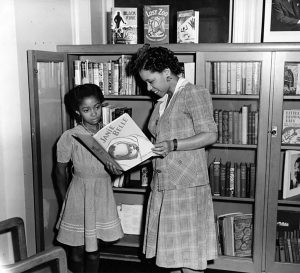
In addition to the ways we interact with library users, the materials we offer them are also an element of customer service. One issue that has emerged with renewed interest in recent years is how library users see themselves depicted in collection materials. Increasingly, the norm for our profession is that people should be able to see themselves, both in the institution, including its staff, and in our collections. Although we have seen antagonistic public commentary and strife about what is on library shelves in recent years, meaningfully diverse collections are something librarians have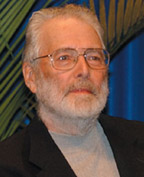 aspired to create for one hundred years or more. Take, for example, the notable work of Augusta Baker (pictured above and to the left), whose accomplishments include having “founded the James Weldon John Memorial Collection of children’s books, a collection of books accurately portraying black children.”[3] Equity and representation also concern academic libraries. For example, the archives and special collections that are often part of a large research library now endeavor to do reparative description of older materials with language now regarded as troubling or offensive. Sanford Berman (pictured above and to the right), a leader in removing offensive language from Library of Congress Subject Headings, worked in both university and public libraries. Much more recently, a student group continued Berman’s efforts, focusing on language that described immigrants in derogatory ways, and their efforts are recounted in the free, streaming documentary, Change the Subject. These are only a few touchstones of this sort of work, which is essential to making users welcome in all kinds of libraries.
aspired to create for one hundred years or more. Take, for example, the notable work of Augusta Baker (pictured above and to the left), whose accomplishments include having “founded the James Weldon John Memorial Collection of children’s books, a collection of books accurately portraying black children.”[3] Equity and representation also concern academic libraries. For example, the archives and special collections that are often part of a large research library now endeavor to do reparative description of older materials with language now regarded as troubling or offensive. Sanford Berman (pictured above and to the right), a leader in removing offensive language from Library of Congress Subject Headings, worked in both university and public libraries. Much more recently, a student group continued Berman’s efforts, focusing on language that described immigrants in derogatory ways, and their efforts are recounted in the free, streaming documentary, Change the Subject. These are only a few touchstones of this sort of work, which is essential to making users welcome in all kinds of libraries.
Across time and place, libraries have demonstrated different ideas about what it means to serve their communities. There is no shortage of innovative and interesting approaches to user services in the present, yet there are also services that the creators of U.S. public libraries would find familiar. This duality means that libraries serve users through continuity and change alike. The library where you work will likely anticipate that you can contribute to evaluating library services to determine what programs and practices should continue and what might be done differently in the future, as well as to the day-to-day work of providing services to users. To bring about innovation, we assess ideas about how to improve our communication and services from other fields, including professionals in areas with different intellectual and social priorities. We can also see what other libraries have done, examining data about users, staffing, and costs to determine the suitability of others’ innovations. Increasingly, drawing on and reasoning about data, sometimes called data storytelling, is seen as a powerful strategy for making decisions about how best to serve users.
Grassroots Report
Current comments and questions:
Three articles from American Libraries follow to offer further examples of distinctive user-centered services. Afterward, you’ll read Theo Prineas’s Starting the Conversation essay and find a list of resources that can help you explore different aspects of improving library services for your community of users.
For an accessible PDF of this article, please click this link.
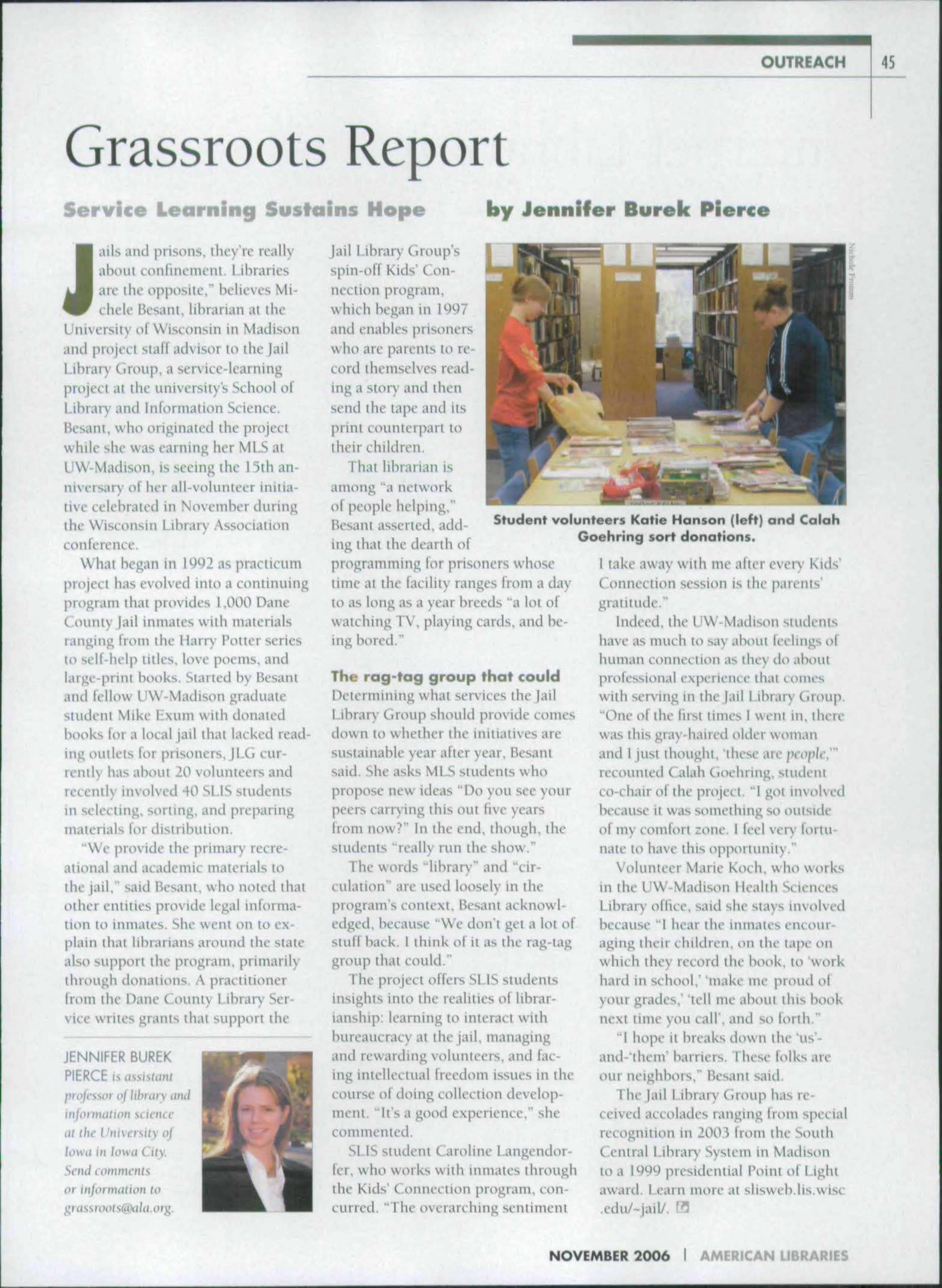

For an accessible PDF of this article, please click this link.
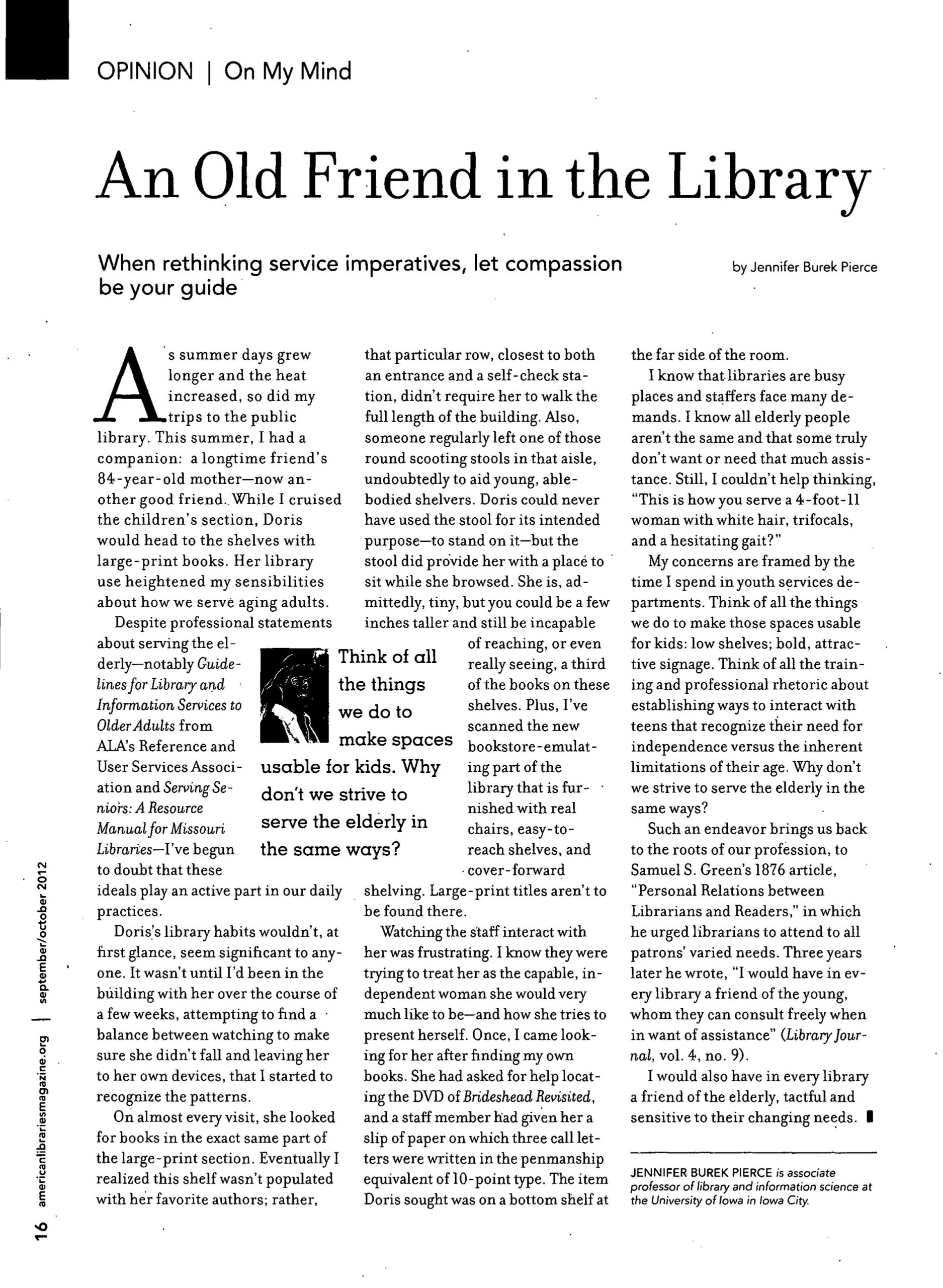

For an accessible PDF of this article, please click this link.
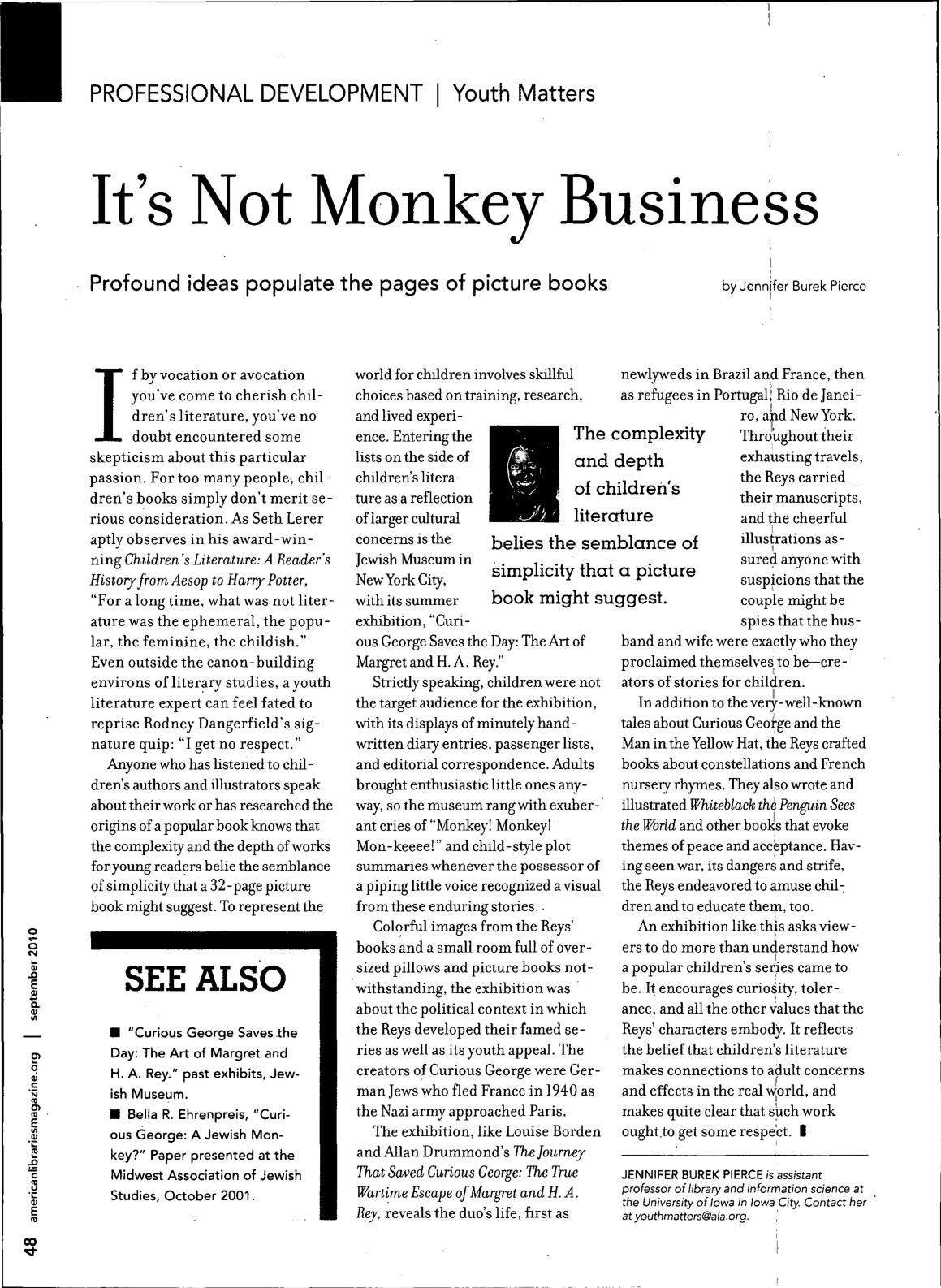

For an accessible PDF of this article, please click this link.
Starting the Conversation: A Response by Theo Prineas
Earlier in this chapter, Jennifer Burek Pierce asks us to consider the question, “How do you use libraries?” My answer would depend on the part of my life I’m thinking about. I grew up in, volunteered at, and later was employed by the Iowa City Public Library. If you ask how I used the library as a toddler, I would answer that I learned how to read there and developed social skills with my peers in the toy area. In elementary school, my parents homeschooled me for two years, which really meant that they were “library-schooling” me in the nonfiction section. When I started at the public library as a volunteer in junior high, I found a community of friendly librarians who showed me how inquisitiveness and learning can deepen my life experiences. As a library employee in high school, the library became a place where I learned how to be responsible about maintaining a job, with practical skills and relationships with my coworkers. My local public library and its services have been so central to my life that I can’t imagine where I would be without it.
The first piece of advice that I was given about pursuing my MLIS was not to do it because I love reading, but rather because I want to serve my community. A year into the School of Library and Information Science, I’m inclined to “yes, and” that piece of advice. In my mind, reading and service to others are intrinsically connected. Reading requires an abrogation of self that allows other minds from the book to temporarily come to life in the reader’s imagination. It is a practice in experiencing otherness. To me, there’s a continuity from the interiority in others found through reading to the imagination and ability required to see others’ burdens and ease them through service in the library. The empathy I practice through reading motivates me to serve others in times of trouble.
Of course, I’m not naive to the fact that libraries often fall short of the high standards we set for each other; a few years ago, the Iowa City Public Library noticed that fines were disproportionately impacting lower-income communities in the city. With service in mind, they determined that the library could function fine-free to reduce that burden on patrons with the most need. They also offer a Bookmobile service that drives out to serve patrons who might face challenges getting to the downtown location. There are still more barriers being erected to library service by outside forces such as budget cuts, book banning, and other legislative challenges. As we move into the future, we must continue to look for places to better serve our patrons. We must also be understanding about the tolls that this could take, especially with the challenges that libraries are facing. Burnout is common among librarians, costing the profession experience and diversity, both necessary ingredients for high-quality service to our patrons. Retaining staff and attracting job candidates from diverse backgrounds requires that we serve each other in the process of serving patrons. It is not selfish to have needs as a worker. We cannot sustain libraries and service to patrons if we are not setting up library employees for a sustainable career. We do that by treating each other with the same values that we apply to serving patrons: access, service, and diversity.
Continuing the Conversation: A Response by Adelina Pineda Canganelli (Fall 2025)
My goal was to learn more about how libraries serve immigrant populations, especially as intermediary points in community programming. I chose this goal because, when thinking about the goal of this assignment, I considered my grandmother’s experience as a Mexican immigrant and the difficulties she faced when arriving in the US due to language barriers and limited access to financial resources. I wanted to better understand how my future career as a librarian can be used to help people in my grandmother’s position: women from poor backgrounds seeking better opportunities, but without the resources or knowledge to even know where to look for help. I chose to watch a webinar from WebJunction titled “Libraries Helping Refugees and New Immigrants Learn the US Financial System.”
The webinar featured a presentation from Ken McDonnell, a financial education program analyst from the Consumer Financial Protection Bureau (CFPB), on the CFPB’s collaborative programming with libraries in outreach programs for immigrants and refugees. McDonnell shared information on the CFPB’s outreach strategies and the collection of consumer data, emphasizing the necessity of providing open opportunities for users to share their needs, rather than assuming what strategies and resources would best serve them. The CFPB focused on both qualitative and quantitative studies of current Limited English Proficiency (LEP) consumer outreach efforts to evaluate the efficacy of in-language resources in libraries, carrying out in-depth interviews with both practitioners who provide direct assistance on financial programming to LEP consumers, as well with consumers via in-language focus groups. McDonell shared that while some takeaways from the groups were unsurprising — for example, that several webpages were out of date and that users requested a wider variety of languages than currently provided — there were some unanticipated points brought up, especially in the focus groups. Several consumers shared that it would be helpful for financial resources to contain parenthetical English translations of key terminology so that they would be able to build a familiarity with important concepts in English without having to seek out additional translations. Additionally, in response to a question posed during the recording of the webinar regarding Spanish-language resources, McDonnell provided an example from one situation in which a Spanish-speaking consumer shared that many of her community members who were seeking out in-language resources were preliterate, and that she had been recording herself reading the information provided through CFPB programming so that they could access it as well. This informed updated approaches to in-language resources, better aligning the CFPB’s work with Executive Order 13166, which requires fair, equitable, and non-discriminatory access to services for LEP consumers.
The examples provided during the talk, as well as the policies and changes they informed, reminded me a great deal of the Wisconsin DPI video that we watched for class. The CFPB’s approach to evaluating and rebuilding their resources for LEP consumers reflected what the Wisconsin DPI emphasized in approaching equitable services for community members — that librarians should not go into these situations assuming they know how to make a resource accessible, but rather they should ask their communities how the library can better serve them. This approach is also reflected in the written Inclusive Services in Wisconsin Public Libraries guide, which states, “The practice of providing inclusive services requires continuous reflection and ongoing dialog with and between library administration, staff, and members of the community, with particular emphasis on including the voices of those who are underserved, underrepresented, and underrecognized within the community” (Wisconsin Department of Public Instruction 2).
In conclusion, in reflecting on my original aims in approaching this webinar, I feel that I learned a great deal about how librarians can best serve underrepresented communities — LEP communities in particular. Not only did I learn more about inclusive terminology (for example, McDonnell and other presenters during the webinar made a point of using the term “preliterate” rather than “illiterate” — I was unaware that the latter term is no longer an acceptable one to use), I was also able to observe how libraries and their cooperating institutions go about a structured approach to understanding the needs of underrepresented communities. Additionally, I find it interesting how much of new library policy is informed by efforts at adherence to government guidelines. This is something that I also observed in researching for the library timeline assignment with the progression of disability rights within libraries — it seems that government policy often provides a structure by which library policies can operate in a more inclusive manner, both at a local and national level.
Works Cited
McDonnell, Ken, et al. Libraries Helping Refugees and New Immigrants Learn the US Financial System. WebJunction, 22 August 2023. https://learn.webjunction.org/enrol/index.php?id=663
Wisconsin Department of Public Instruction. Inclusive Services Assessment and Guide for Wisconsin Public Libraries. Sept. 2019, https://dpi.wi.gov/sites/default/files/imce/libraries/Publib/InclusiveServices/Inclusive_Services_Assessment_and_Guide_for_Wisconsin_Public_Libraries_2019_updated_Sept.pdf
Resources for Further Reading, Listening, and Viewing
“Palaces for the People,” Episode 346, 99% Invisible (March 19, 2019), https://99percentinvisible.org/episode/palaces-for-the-people/.
Barbakoff, Audrey and Noah Lenstra, The Twelve Steps to a Community-Led Library (ALA Editions, 2023).
Best Practices for the Customer Focused Library (Burr Ridge, Ill.,Metropolitan Library System, n.d.), https://www.webjunction.org/content/dam/WebJunction/Documents/webjunction/CFLBestPractices.pdf.
Ronald Block & Julie P. McNeil, “Get to Yes: Branding Public Library Service,” Public Libraries (Jan./Feb. 28, 2015), https://publiclibrariesonline.org/2015/02/get-to-yes-branding-public-library-customer-service/.
Campana, Kathleen, et al., “‘A Library-School’: Building a Collaborative Preschool-Library Partnership to Support Whole Family Engagement,” Early Childhood Education Journal 50, no. 1 (2022): 71-82. https://link.springer.com/article/10.1007/s10643-020-01127-4.
Evergreen Branch Library SJPL, “Library Customer Service: Dos and Dont’s,” YouTube (Jan. 12, 2016), https://www.youtube.com/watch?v=-RexvkkLrkw.
Expanding Information Access for Incarcerated People Initiative, (San Francisco Public Library, 2023),
https://sfpl.org/services/jail-and-reentry-services/expanding-information-access-incarcerated-people-initiative.
Patterson, James and Matt Eversmann, The Secret Lives of Booksellers and Librarians: True Stories of the Magic of Reading (New York: Little, Brown & Co.., 2024).
Seeing Race Before Race: A Closer Look (Chicago: Newberry Library, n.d.), https://digital.newberry.org/rb4r/.
Footnotes
- Pundsack, Karen. “Customers or Patrons? How You Look at Library Users Affects Customer Service.” Public Libraries (March 2015). https://publiclibrariesonline.org/2015/03/customers-or-patrons-how-you-look-at-your-librarys-users-affects-customer-service. ↵
- Barron, Sophia Bernazzi. "What Is Customer Service? The Ultimate Guide." Hub Spot, (n.d.). https://blog.hubspot.com/service/customer-service. ↵
- University of South Carolina Libraries. "Augusta Baker Collection of African-American Children's Literature and Folklore." https://sc.edu/about/offices_and_divisions/university_libraries/browse/irvin_dept_special_collections/collections/augusta_baker_childrens_literature.php. ↵

